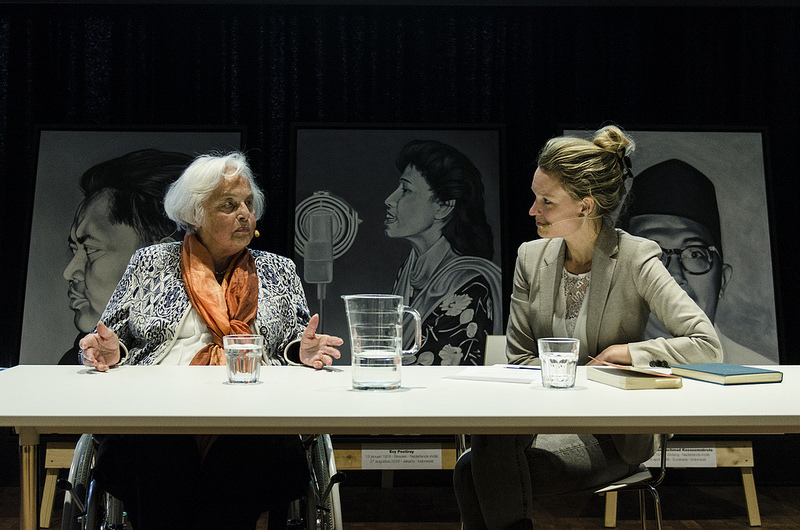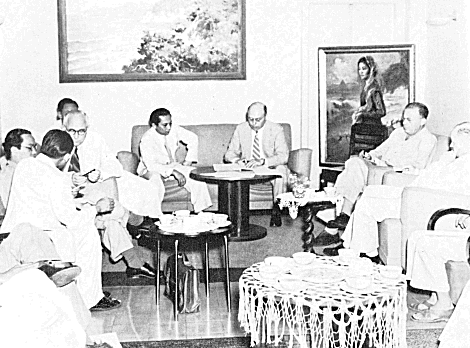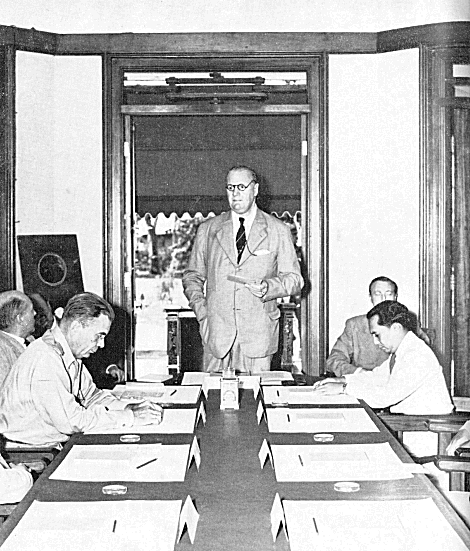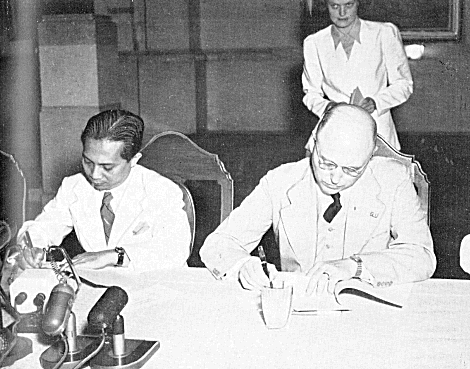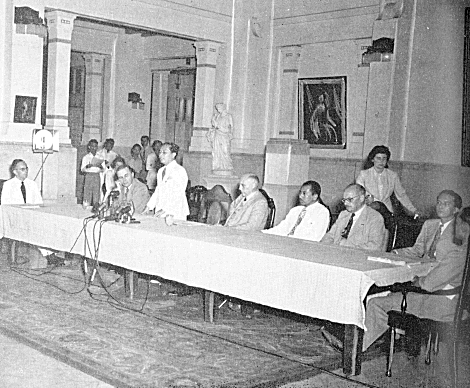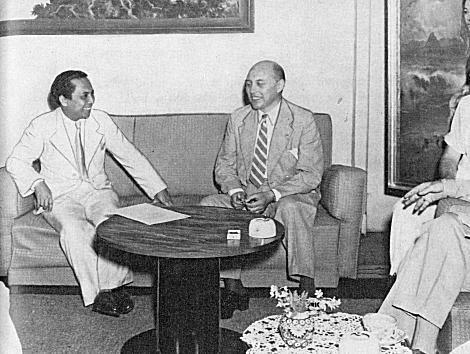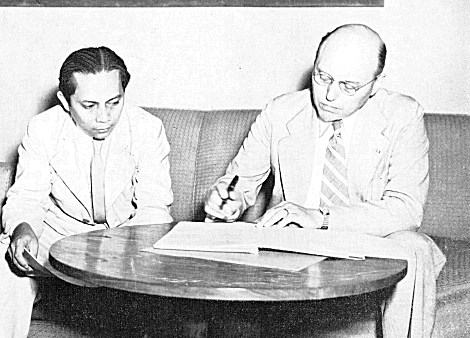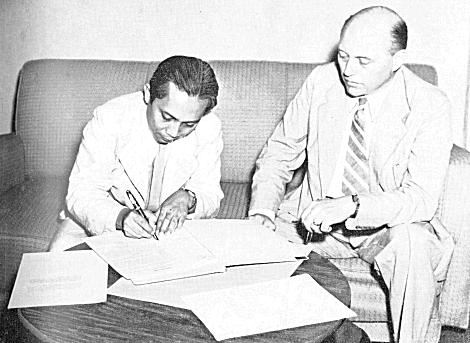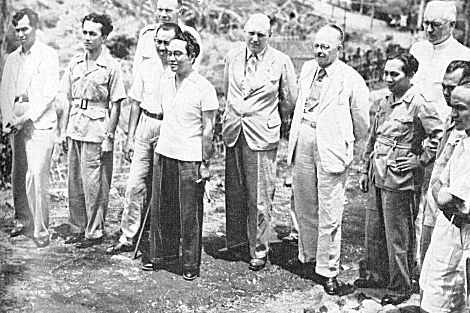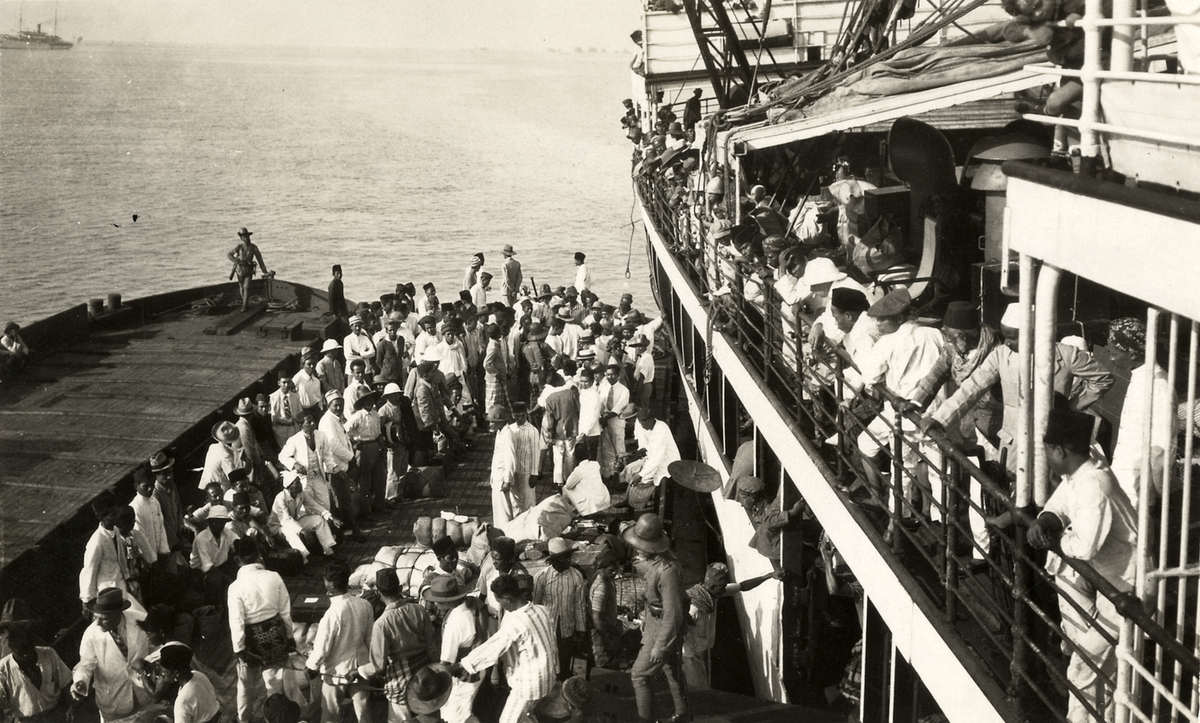Sutan Sjahrir: Indonesian revolutionary
In 1935 the twenty-six-year-old revolutionary Sutan Sjahrir sailed, together with several other prisoners and some guards, onto a brown-yellow river in the New Guinean jungle. The group was on their way to the Dutch concentration camp Boven-Digoel. Sjahrir had been imprisoned there for a year without any kind of process, on suspicion of hate speech and disruption of the public order. In one of the letters to his Dutch wife, which were later published as the Indonesische Overpeinzingen (published in English as Out of Exile), Sjarhrir wrote that he was punished because all he wanted to do was to serve his people. Sjahrir was a man of great intelligence, courage and inspiration, and his letters form an important source for historical research into the perspectives of Indonesian intellectuals in the colonial Dutch Indies. He nevertheless has not received much attention in the Dutch postcolonial debate. In this section Anne-Lot Hoek introduces Sutan Sjahrir, about whom she had previously published as a journalist, aiming for more interest in the Dutch debate over the struggles and search for freedom of the leaders of the Indonesian revolution.
Featured image: Sutan Sjahrir speaking to the provisional parliament, 1947, by Cas Oorthuys. Source: Nederlands Fotomuseum Rotterdam.
On 15 November 1946 the agreement of Linggadjati was concluded in which the Dutch government and the Republik Indonesia agreed on a first step towards Indonesian self-government. Sutan Sjahrir signed the agreement on behalf of the Republik Indonesia. The negotiations took place at Linggadjati, a mountain village in West Java. The photos show Sjahrir in the negotiations, as well as the former Dutch prime Minister Wim Schermerhorn, who led the negotiations, and the Dutch Lieutenant-Governor General Van Mook. The photos are taken from the diary of Wim Schermerhorn.[efn_note]C. Smit, Het dagboek van Schermerhorn [Schermerhorn’s diary] (Utrecht: Nederlands Historisch Genootschap, 1970).[/efn_note]
Dissenting voice imprisoned
Indonesian nationalism crossed borders early on, and the rise of nationalism inspired the creation of new networks extending beyond the Netherlands and the Netherlands Indies. As Klaas Stutje wrote: “the Indonesian student community can serve as a good example in the Dutch imperial context of the idea among British historians that the Imperial Project was not only an act of intrusion of a colonial power in foreign lands, but to some extent also worked in the opposite direction with regards to the circulation of people, ideas and political forces.”[efn_note]Klaas Stutje, “Indonesian identities abroad International Engagement of Colonial Students in the Netherlands, 1908-1931,” BMGN, volume 128-1 (2013): 153. This text is based on previous journalistic work, in particular the article: Anne-Lot Hoek, “In naam van merkeda,” [in the name of Merkeda] De Groene Amsterdammer, August 2, 2017.[/efn_note] As early as 1913, individuals within the Dutch-based ‘Indische Vereeniging’ started to move in a nationalistic direction, mainly inspired by the Menadonese Sam Ratulangie, Soewardi Suryaningrat and Tjipto Mangoenkoesoemo. Indonesian nationalism in the Netherlands flamed up in 1918 after the First World War, when Indonesians inspired by the American president Woodrow Wilson called out for the right to self-determination. The Indonesian music-teacher and nationalist Raden Mas Soorjo Poetro wrote a pamphlet during the Dutch governmental elections in 1918, calling on his countrymen in the Netherlands to vote for the party that was most apt to support Indonesia in its struggle for independence, the socialist party. “Voting countrymen! The becoming state of Indonesia is in need of the most important thing: the right to self-determination. [..] Vote for the party that is in favor of the detachment of Indonesia of Holland. Vote red!”[efn_note]‘Een Indiers uitspraak,’ Het Volk: dagblad voor de arbeiderspartij, July 2, 1918.[/efn_note]
In 1929 Sjahrir joined the political movement Perhimpoenan Indonesia (PI) – the successor of the Indische Vereeniging – when he studied economics in Amsterdam and where he was in contact with Dutch as well as Indonesian intellectuals. Other nationalists, like Mohammed Hatta, Achmad Soebardjo, Abdulmadjid Djojoadhiningrat, Raden Slamet Faiman and Rachmad Koesoemobroto, had also been or were also part of this movement. In 1931 Sjahrir returned to Indonesia with the goal of raising the consciousness of Indonesians.
Sjahrir was a socialist whose thoughts about freedom focused on democracy and internationalism, as well as on the rights of the individual. He was an Indonesian who criticized the colonial experience, like Kartini (1879-1904), Soewardi Soerjaningrat (‘If I had been a Dutchman’, 1913) and among many others including the poet Chairil Anwar and S. Rukiah Kertapi, the forgotten female writer of the Indonesian revolution. His publication ‘Indonesische Overpeinzingen’ (1945) is an important source for understanding how Indonesians living within the Dutch colonial state have written about their individual experiences and their rights.[efn_note]Sutan Sjahrir, Indonesische Overpeinzingen [published in English as Out of Exile] (Amsterdam: De Bezige Bij, 1945).[/efn_note] It shows many of the ambiguities that Sjahrir encountered in the colonial context and on which he would later reflect. As Paul Bijl writes, ‘the legal spaces produced by Dutch colonial law – the prison cell, the camp, the island as a place of exile – have ambiguous legal meanings for Sjahrir as, on the one hand, it is the law that produces them, yet, on the other, they stand outside the law.’[efn_note]Paul Bijl, “Human Rights and Anticolonial Nationalism in Sjahrir’s Indonesian Contemplations,” Law & Literature, 29:2 (2017): 252.[/efn_note]
Indonesische Overpeinzingen shows the violent colonial context of the Dutch Indies. Indonesians did not have civil rights as the Europeans living there did. Those who protested against that situation, like nationalists and alleged communists, were stigmatized and imprisoned. ‘Anyone who is even slightly suspected of leftist sympathies is labelled as a communist’, wrote Sjahrir. Of course, not everyone who was called a communist was one. ‘Oftentimes people are called communists in order to make prosecution of them easier’, he argued.[efn_note]Ibid: 95.[/efn_note] Not long before Sjahrir returned to Indonesia, there had been police raids on (alleged) communists. The leaders of the resistance, including Sukarno, had been imprisoned. Soon after Sjahrir settled in Indonesia, he became a suspect as well. In 1934 Sjahrir was arrested. Both of his brothers and his sister-in-law were fired from their jobs, his acquaintances were spied on, and all of the people he and his family were in contact with were suspects of the Dutch Indies intelligence service.[efn_note]Kees Snoek, “Soetan Sjahrir. De strijder,” [Soetan Shahrir. The warrior] in Rosemarijn Hoefte, Peter Meel & Hans Renders (ed.), Tropenlevens. De (post)koloniale biografie [Tropical lives. The (post) colonial biography] (Leiden/Amsterdam: Boom, 2008), 170-171.[/efn_note]
Sjahrir was not the only person imprisoned because of his political ideas. Between 1926 and 1942, thousands of other people were locked away in Boven-Digoel, especially alleged communists[efn_note]Journalist Karin Amatmoekrim wrote an article about Boven-Digoel for the online platform De Correspondent in a series about ‘silenced histories’ in which she compared it to Guantánomo because it was a place of exile where political prisoners were banned without trial. Karin Amatmoekrim, “Hoe Nederland zijn strafkamp in Nieuw-Guinea trachtte te vermommen.” [How the Netherlands tried to disguise its prison camp in New Guinea] De Correspondent, March 7, 2018.[/efn_note]. Sjahrir described this place as unpleasant, terribly hot, ‘uninspired’ and a camp where people withered away into ‘mental ruins’ as a result of malaria and mental illnesses.[efn_note]Sjahrir, Indonesische Overpeinzingen, 58, 60.[/efn_note] As an inmate, Sjahrir had to build his own hut and provide his own clothing and food. There was a possibility to earn some income through labor, but when one was unable to work, one was dependent on fishing from an almost empty river. The conditions that Sjahrir described show the extreme consequences that dissenting voices in the Dutch Indies met when speaking out on colonial injustice.
The photo shows communist prisoners, taken back and interned at Boven-Digoel. Indonesia, 1927.[efn_note]Spaarnestad Photo, collection Het Leven (unknown photographer), ‘Communistische gevangenen. Geboeid worden een aantal communistische “raddraaiers” van boord gezet en geïnterneerd op Boven-Digoel. Indonesië, 1927’ [Communist prisoners. A number of Communist “wheel-turners” are handcuffed and boarded at Boven-Digoel. Indonesia, 1927]. See: Geheugen van Nederland. [/efn_note]
Addressing the Dutch double standard
The general idea in the Netherlands was that the inhabitants of the Indies were given schooling and healthcare, and the conditions in Digoel or the fates of others who were critical of the system were mostly unknown. In his letters, Sjahrir flawlessly showed the double standard of the Dutch in regards to their colony. He read In de Schaduwen van Morgen by the famous historian Johan Huizinga (1935), who painted a very dark picture of a Europe where Hitler and Mussolini were in power and where the internal moral decay of Western society lay at the roots of totalitarianism. Huizinga described ‘the suffering of the times’. Whereas the book was received very positively by most Dutch intellectuals, Sjahrir saw it as a disappointment. Huizinga condemned the killing of people as done by Germany in the early 1930s but stated that violence could be justified to defend one’s own legal order. ‘Killing and protecting – of who and against which groups?’ the revolutionary asked himself doubtfully. ‘What do the Germans do other than defend the legal order – their legal order – with all possible means that those in power have at their disposal?’ In the Dutch Indies there were police raids against alleged communists. According to Sjahrir, Huizinga was one-sided in painting the image of the times: he criticized Germany but accepted ‘the gummy bat, the rattan stick, the whip, concentration camps, imprisonments’ to defend his own legal order, and thereby overlooked the civil rights of millions of Indonesians. This injustice was not addressed by Huizinga in his best seller, and thereby he put his readers ‘on the wrong track’, according to Sjahrir.[efn_note]Sjahrir, Indonesische Overpeinzingen, 88-93.[/efn_note]
The ‘wrong track’ that Johan Huizinga put his readers on by portraying an ethical colony that knew no oppression, fed a longer existing idea of a tolerant and innocent nation, that still exists in Dutch society. One might wonder whether Huizinga knew about the framing and prosecution of large groups of people as enemies of the state, as was the case in the Dutch Indies. Sjahrir believed that Huizinga’s blind spot was caused by his Calvinist worldview, a view full of ‘hedges and ditches’ and small spaces, appealing to the Dutch moral framework: ‘The Dutch mind, the authentic Dutch parochialism, that does not know how to differentiate between small and large’.[efn_note]Ibid, 89.[/efn_note]
Huizinga found himself in a tradition that was rooted in Ethical Politics, the Dutch colonial approach as it had been constructed at the end of the nineteenth century by leftist and Christian politicians. The capitalist exploitation of the colony had to be redeemed by the development of its indigenous inhabitants, with a possibility of autonomy. It became a ‘white man’s burden’ – the idea that the white man had to help the black man to become civilized. Colonialism was in the interest of the Indonesian people. That these Ethical Politics were based on the idea that one group was superior to the other did not raise questions for Huizinga in the 1930s, as Sjahrir suggests.
The tradition of ethical, colonial politics persisted into the setting up of development aid in the 1960s. One of the most prominent supporters of Ethical Politics, Charles van der Plas, put all his energy into the development aid that was organized after Indonesia had gained its independence. He was not the only one: many former colonialists transferred to the Dutch development aid efforts that were established in Indonesia in the 1960s by the Dutch Minister of Foreign Affairs, Joseph Luns. The United States went into the world to make it better, and the Netherlands could not stay behind. The essence of the Dutch development aid (or as it was later called: development cooperation) could be traced back to the ethical tradition: the idea that not only the Indonesians needed the Dutch to become developed, but that this need for Western help also applied to the whole African continent.[efn_note]See for instance: Inge Brinkman in cooperation with Anne-Lot Hoek, Bricks, mortar and capacity building, A Socio-Cultural History of SNV Netherlands Development Organisation (Leiden: Brill, 2010).[/efn_note] The core of the idea, the colonial system, was overlooked.
Creating hope at Linggadjati
Back to Sjahrir in the Dutch Indies. In 1942 the Second World War had also broken out there – the archipelago was occupied by Japan. The Japanese freed Sjahrir from his exile, but he, unlike other Indonesian revolutionaries, was not willing to cooperate with a fascist regime. In his ideals on democracy and human rights he proved to be unambiguous. When the Indonesian fight for freedom broke out in 1945 and many people associated with colonialism, including Dutch, Chinese, Menadonese (from North Sulawesi) and Moluccan people (from Maluku), were attacked and or killed, Sjahrir categorized this violence as ‘fascist cruelties’ in his pamphlet Onze Strijd (1945).[efn_note]Sutan Sjahrir, Onze Strijd [Our Struggle] (Amsterdam: Vrij Nederland, 1945).[/efn_note] At the same time he soon proved to be a skilled negotiator with the Dutch from his position as the first prime minister of the Republic of Indonesia. His anti-Japanese attitude gave him the advantage with the Dutch over Sukarno, who was seen as a collaborator.
Sjahrir reached out internationally in his fight for independence. It is, for instance, little known that Australia played a role in the revolution: longshoremen refused to load the Dutch ships carrying arms and supplies and setting sail for Indonesia. Sjahrir addressed these workers in a radio speech[efn_note]Radio broadcast from 1945, inserted in the article Australian waterfront workers support Indonesian independence against the Dutch. Website ABC news Australia.[/efn_note] stating that the Indonesians stand together with Australia against “all enemies of freedom.”
After protracted negotiations the Linggadjati Agreement was finally drawn up between the Netherlands and Indonesia in November 1946, named after the Javanese village where the ‘basis-agreement’ was signed. The harmonious negotiations were led by former Prime Minister Piet Schermerhorn and Sjahrir. His daughter Upik repeated the words Sjahrir spoke out during Linggadjati at the Dutch embassy in 2009:
“The agreement we sign today is a first step towards freedom from this suffocating condition, a first step in our pledge to banish darkness and bring back a time of brightness and clarity, a time of objectivity. A time when the cry for ‘Freedom!’ no longer threatens humankind, but is instead a cry for humanity that will move each and every human being, in a new time of liberation where our humanity is easily moved by any utterance of humanity. The world is full of conflict, of dangers of war, of darkness. In Indonesia we are lighting a small flame, a flame of humanity, a flame of common sense, that aims to get rid of the darkness, the conflict that has ensued from and resulted in rape and destruction, suffocation, and darkness. Let us now care for this flame so it will continue to burn, and burn even brighter. May it be the beginning of light throughout the whole world.”[efn_note]Speech Upik Sjahrir on Exhibition ‘The Linggadjati conference’ in The Hague, February 15 2010. Website of the Indonesia Nederland Society.[/efn_note]
However, despite the clear message of hope and connection, many conservative Dutch saw the treaty as a failure. The Dutch government changed their part of the treaty, and in the summer of 1947 all the built-up hope turned into a military operation: the First Police Action or Agressi Belanda I.
Legacy of inspiration
In 1949, after Indonesia became independent, Sjahrir soon came into conflict with Sukarno, the charismatic leader of the revolution and the first president of Indonesia, who imprisoned him. Siti Rabyah Parvati, ‘Upik’, the daughter of Sjahrir and his second, Indonesian wife, was only three years old when her father was arrested and locked up without any kind of legal process. In 2009, she was invited by the Indonesian embassy in The Hague to give a moving speech about her father. “Sjahrir, a man of peace, was unable to enjoy the love of his family and his children” she said about her father. In 1965, General Suharto took power. The ghosts of the communist enemies of the state came back under the influence of the United States. Hundreds of thousands of Indonesians were murdered.
Sjahrir had been sent to Switzerland by Sukarno that same year because of health problems, where he was reunited with his family. Siti sat on his lap every day and saw the tears running down his face, as she recounted in her speech. The family would not be together for a very long time – in 1966, Sjahrir passed away. “When we returned to Indonesia, we made a short stop at Schiphol, where a short ceremony was held in honor of my father,” said Siti. Former Prime Minister Schermerhorn and several other Dutch politicians and friends paid their respects.
After he died he was declared a national hero in Indonesia and received a state funeral attended by a huge crowd of people. It was somewhat remarkable after his long imprisonment. The Indonesian Soewarsih Djojopoespito stated: “Flowers and flower petals were spread from a helicopter….A funeral like for a hero, like for a king, carefully organized. Why had nobody raised a voice to get this man free?”[efn_note]Rudolf Mrázek, Politics and Exile in Indonesia (New York, Cornell Southeast Asia Program, 1994), 494.[/efn_note] Rudolf Mrázek, who wrote a biography on Sjahrir, stated that Sjahrir in Indonesia remained “misplaced” in the memory of his role in the revolution. At the same time, of the ‘Big Three of the Revolution’ – “after all marginality he had lived through” – he became the only one who was buried at the center- stage, in the state heroes’ cemetery.[efn_note]Ibid, 497.[/efn_note]
In the Netherlands he has been almost forgotten. Mrazek writes that Sjahrir’s imprisonment in 1962 received little attention in Holland: “Even in The Netherlands itself, however, after all these years, Sjahrir seemed to be not much more than a name from a distant past remembered with some difficulty.”[efn_note]Ibid, 464.[/efn_note]In Dutch history, the dissenting voice of Sjahrir – as of many other foremen of the Indonesian revolution – is largely overlooked. Sjahrir challenged and criticized the colonial system and the Dutch national narrative, and presented a mirror that still holds up till today. His legacy is, however, that of connection between Indonesia and the Netherlands. In her speech in the Netherlands, his daughter expressed her wish that her father’s ideas would not be forgotten and would be an inspiration for young people and world leaders, “and be a light that shines the souls of our people.”[efn_note]Upik Sjahrir, 2010.[/efn_note]
For many Dutchmen he has been that inspirational voice indeed, for instance for Joty ter Kulve – van Os (Semarang 1936), who is the chairman of the Indonesia-Nederland Society. The Linggadjati agreement was signed at her parental home.[efn_note]Joty ter Kulve – van Os visited the parental home in 2012, a journey captured in the form of a documentary made by Twan Spierts ‘Terug naar Linggajati’ [Back to Linggajati], which was screened by Omroep West on 14 October 2012.[/efn_note] Ter Kulve was inspired by Sjahrir to culturally connect the two countries and their shared history, a mission she spends a lifetime working on. Sjahrir was an inspiration for progressive Dutchmen during the Indonesian independence war, such as for civil servant Siebe Lijftogt and also for post-war dissenting voices such as author Rudy Kousbroek and younger critics such as historian/politician Zihni Özdil. Sjahrir, his ideas and his lifestory are just as much part of Dutch history as the ‘Soldaat van Oranje,’ – the most famous Dutch freedom fighter – and should be given an equal place within Dutch national memory.
